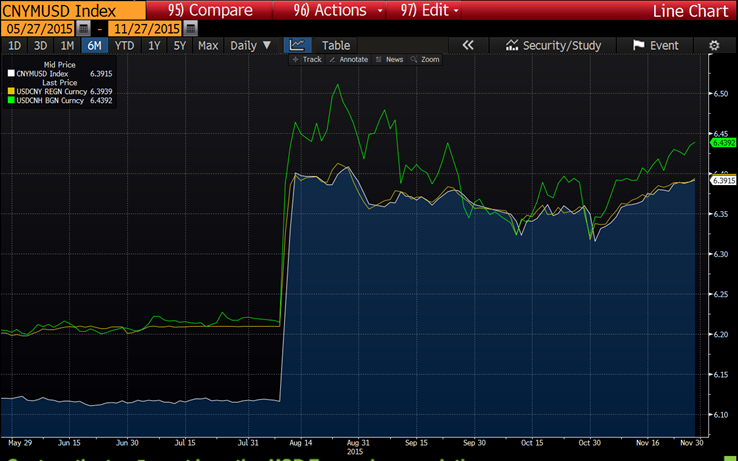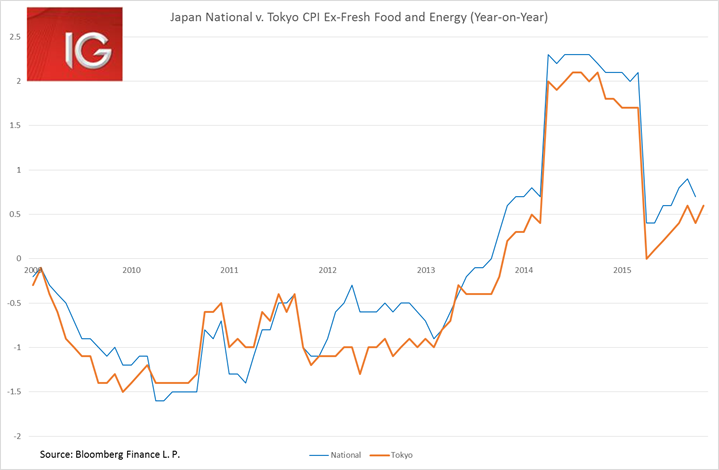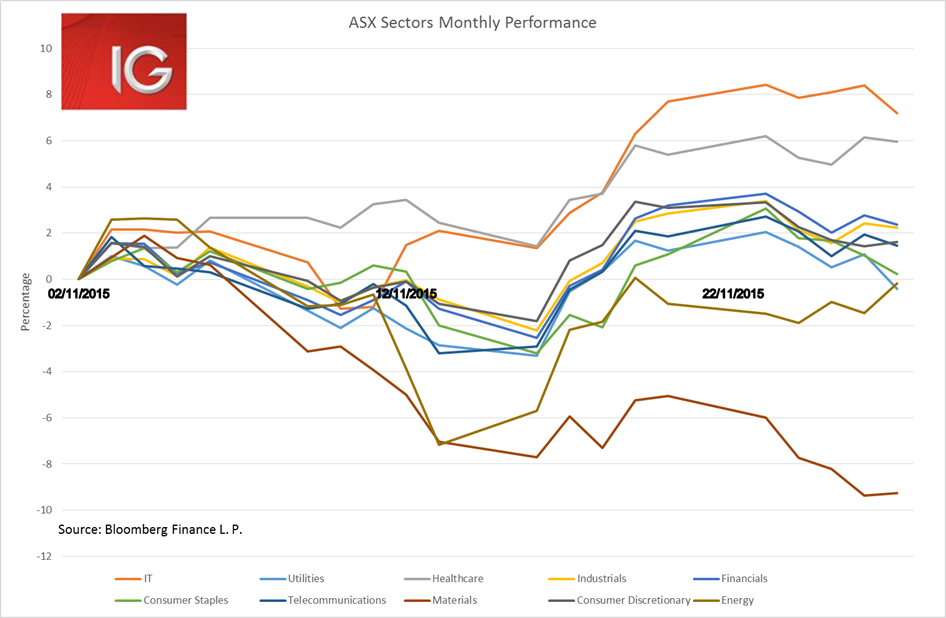The big drop in Chinese industrial profits plus the weakest CNY mid-point fix since 31 August appear to have set off a wave of selling in equity markets across Asia.
The bigger concern is certainly the potential for China to steadily devalue the CNY. The International Monetary Fund (IMF) is set to include the Chinese yuan as part of its Standard Drawing Rights (SDR) basket on 30 November. Since the IMF indicated it was likely to do so last week the CNY has had its mid-point steadily weaken. It’s uncertain if the Chinese government is keen to show the market influence in their rate setting or whether now that they know they have gained SDR inclusion they are keen to weaken their overvalued currency knowing it will not jeopardise their case.
Nonetheless, a noticeable weakening of the CNY appears to be poison for equity markets. The devaluation in August prompted the big global selloff in equities. It appears China devaluing its currency heightens concerns over its ability to consume global exports.
The offshore CNH is now trading at its weakest level since 24 September:

Chinese industrial profits fell back in October, declining 4.6% year-on-year and further declines in the numbers look likely with China’s manufacturing PMIs staying consistently below 50.

Japan
A fairly disappointing range of Japanese data was released today, which did not help Japanese equity markets. The jobless rate did decline more–than-expected, but employment has not been Japan’s problem.
The Nikkei 225 began slipping as soon as the poor CPI and Household spending figures were released, with the selling being most prevalent in the utilities, materials and financial sectors. The index and the Japanese yen then dropped even further on the weakest CNY fix since 31 August and the poor Chinese industrial profits figure.
It was the weakening of the Ex-Fresh Food and Energy CPI and the big decline in household spending that were of most concern. Even though the job rate continued to improve, the 2.4% year-on-year (YoY) decline in household spending (versus expected 0% growth) certainly indicates that despite the new jobs, incomes are still yet to increase dramatically enough to prompt increased consumption.
The inflation data was mixed depending on which data series and timeframe one looks at. But the key takeaway is inflation looks to be broadly weakening further rather than increasing, a finding unlikely to warm the cockles of the Bank of Japan (BoJ). Given the large fall in the oil price, the focus is on the Ex-Food and Energy CPI number. This number fell to 0.7% YoY in October from a previous 0.9%, eliminating the steady increases of the past two months.
The only bright spot for some may be the leading Tokyo CPI numbers for November. The Tokyo Ex-Fresh Food and Energy number did bounce back from its YoY decline in October, but weakened further in month-on-month (MoM) terms. More worryingly, the headline CPI for Tokyo declined 0.4% MoM, its biggest monthly drop since November 2014. This does not bode well for the national numbers in November. The BoJ appear loathe to increase their easing program for the moment, but if these data trends continue, calls for them to do so will only gather pace in the first half of 2016.
The spike in 2014 corresponds to the tax hike introduced in April that year:

ASX
The move in metals markets over the past few days has been welcomed by the battered materials sector. The pullback in the US dollar has also been a boost to energy and materials sectors. The good performance of European markets (US markets were closed for Thanksgiving) also helped set the ASX up for a strong start.
Good buying for the banks helped the index throughout most the day, but poor data out of China and Japan and a further weakening of the CNY midpoint saw the ASX pull back alongside all the other major Asian markets. After almost touching 5260 at the open, the index proceeded to lose over 1% from that point.
General market sentiment clearly moved down after developments in Asia. All the banks opened up on the day, but by the afternoon the whole financial sector was down 0.4% with all the top five banks in the red.
The energy sector was the best performing, managing to still gain 1% despite selling across the index, with large caps Woodside Petroleum Ltd (AX:WPL) and Origin Energy Ltd (AX:ORG) seeing the best performance.
Large cap diversified miners BHP Billiton Ltd (N:BHP) and Rio Tinto PLC (N:RIO) both managed to find some respite as heavily sold metals prices saw a bit of a jump. Their huge market cap weighting managed to help keep the materials sector in the green, as it added 0.1%.

Weekly Performance:
IT -0.5%
Utilities -1.6%
Healthcare +0.5%
Industrials -0.6%
Financials -0.8%
Consumer Staples -0.8%
Telecommunications -0.4%
Materials -4.4%
Consumer Discretionary -1.4%
Energy +0.9%
